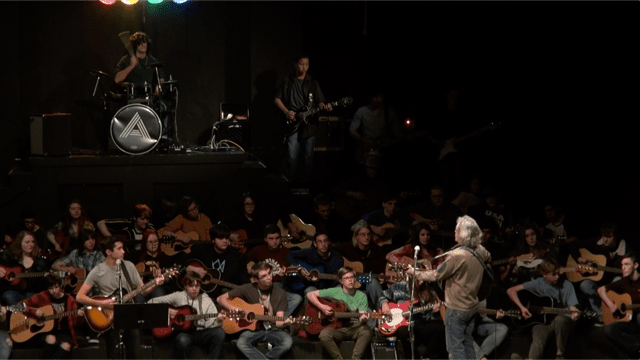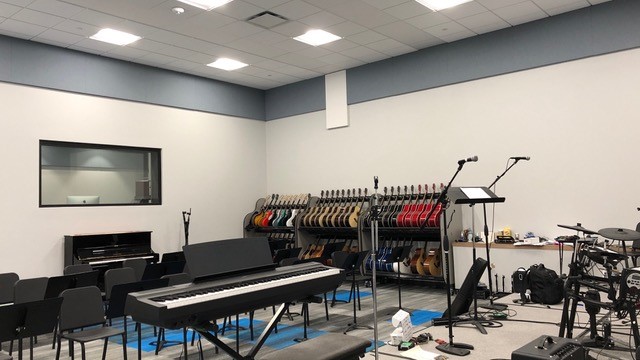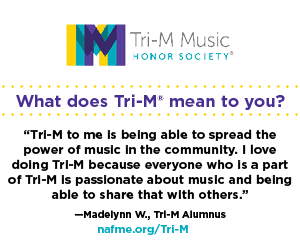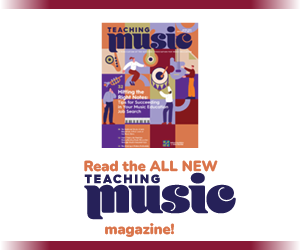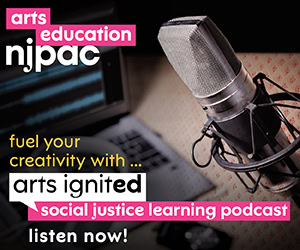/ News Posts / Guitar Class in the Natural State
Guitar Class in the Natural State
Number 29: The State of Arkansas
By Thomas Amoriello, Jr.
NAfME Council for Guitar Education Chair
During the 50 States of Guitar Class Series we have visited a variety of programs across America that use the guitar as a vehicle for creativity in a variety of forms from classical technique to modern styles. In this edition, the NAfME Council for Guitar Education visits Rogers, Arkansas. The Arkansas Arts Academy’s high school guitar program is led by David Singleton and is among the very few in the nation that approaches guitar instruction through what may be America’s most influential, far-reaching art form: rock ‘n’ roll.
While the bulk of the repertoire is based on classic rock, consideration is also given to the study of more current music selections that are relevant to students. As the students progress through the program, they are exposed to other important American contributions to music such as blues, folk, country, and jazz. They also explore sub-genres of these styles like bluegrass, modal jazz, heavy metal, etc. The ultimate objective of the program is to help the aspiring guitarist achieve proficiency, and then make advances toward mastery of the instrument by developing the confidence and skills needed to perform successfully as a soloist and part of an ensemble.

Photo courtesy of David Singleton
Concerts and live performances are another part of what makes this program special. Students with little or no experience performing in front of an audience can get their start by performing onstage surrounded by a large ensemble. As the student becomes more confident in their skills on and off stage, they have opportunities to perform live with a smaller ensemble or as a soloist. No audition is required to enter the program.
Thank you, David, for sharing your insights with the NAfME membership.
What kind of classes related to the guitar do you teach?
I currently teach guitar classes, audio production, singer/songwriter classes and an audition-only ensemble called The Rockhoppers.
Please tell us about your school and overall music program.
Arkansas Arts Academy (AAA) has a K–6 campus and 7–12 campus, both located in Rogers, Arkansas. We are an open-enrollment public charter school offering fine arts education to K–12 students. AAA is the second oldest and one of the largest charter schools in the state. Our school offers art programs in Visual Arts, Music, Dance, Theater, Creative Writing, and Culinary Arts.
The 7–12 music program combines traditional offerings in choir, symphonic orchestra, string ensembles, brass/wind ensembles, AP music theory, etc., with a new Modern Music program focused primarily on the study of American music such as Rock ‘n’ Roll, Blues, Jazz, Country, etc. Modern Music class offerings from 2019-2021 include four levels of guitar, electric guitar lab, classes in bass, percussion/drums with an electronic drum lab, piano with a piano lab, singer/songwriter classes, audio production, music technology and several ensemble-based classes.
Please tell us about your own personal musical background growing up and your collegiate experience.
I grew up in Suffern, New York, which is located about 35 miles northwest of New York City. I got an introduction to playing guitar in a junior high school 8th grade guitar class but didn’t own a guitar until 9th grade. Once I had a guitar, I was hooked, and started practicing for several hours each day. Not long after getting the guitar I was recruited to play in a rock band. I had no business playing in a band at that point, but the guys wanting me to play were big and intimidating, so I went along with it. We rehearsed and played some shows, but I quit within five or six months of joining because I didn’t think we sounded that good, and I needed more practice. As it turns out, everyone in that band is a professional musician! I took some of my first private guitar lessons at a local music store during that time and developed better right-hand technique along with learning more chords.
All of my musical experiences throughout high school took place outside of school hours since there weren’t any opportunities for guitar study. I played in lots of rock bands, studied privately off and on with different teachers and practiced a whole lot. My high school years were from 1979-1983 so there wasn’t YouTube, or even much in the way of rock guitar tab transcription books at that point.
I remember purchasing a Led Zeppelin music book thinking it would show me how to play the guitar parts to their songs, but the only thing it showed were chord diagrams above a piano/vocal score. I kept trying to figure out how that Aminor chord pictured in the first position lined up with the intro of the song. I eventually came to find out that it was an Aminor chord, but Jimmy Page had played a different voicing of an Aminor chord up the neck in the seventh position.
The only way you were going to learn anything you wanted to play was to put on the record and learn it by ear or have someone show you up close. I got to be pretty good at playing by ear and for a long time learned songs nightly from most of the albums I owned.
While playing by ear came in handy for learning how to play rock ‘n’ roll, and landing me a bunch of private guitar students after graduating high school, it wasn’t going to help me get into a music program at a university, so I studied classical guitar privately while taking music theory and ear training classes at Rockland Community College. I was very fortunate to have pianist, composer, and conductor Haim Elisha as a professor there. I’m sure he couldn’t have told you my name even after I was there for a year, but during my second year he started to take notice of my work in harmony/voice leading. He would regularly play or show my work to classes, and began to give me other students’ homework to grade. I loved the challenge of avoiding all of the direct and parallel 5ths, 8ths, etc., and spent countless hours working on it.
I started private piano lessons with him, working on Beethoven, Bach, Mozart, etc. I began spending more time on piano than guitar, and was listening to classical music almost exclusively. He encouraged me to give composing a shot, so we started working that into lessons as well. After working on composition for a while, he was convinced that I should study music composition instead of guitar. I wasn’t enjoying classical guitar anywhere near as much as classical piano, so that sounded good to me. He believed in my abilities far more than I did and was the most important teacher in my life. I didn’t believe in myself enough to even submit applications to schools that he thought I should, and being a procrastinator had missed every deadline for applying anywhere, but I couldn’t do another year of community college having racked up four years already trying to figure out what I was going to study!
I somehow got myself to call SUNY Purchase and managed to get a meeting with the Dean of Music. I brought him my compositions; he had me play some piano, tested my ears with intervals, chords, etc., and then accepted me into the school. It was one of the best days of my life. I was older than most of the students there and a commuter since I worked doing lessons, gigs, etc., but I got to study with some amazing musicians. I’ll never forget watching/listening to Anthony Newman improvise four voice fugues during classes. During those years I also studied privately with Arthur Cunningham and Michael Starobin. I graduated from Purchase with a BFA in music composition.
What obstacles did you face when you were first hired at your school? Now?
Aside from working full-time as a post-production audio engineer for five or six years, a big part of my income had always been teaching private guitar lessons (I had 65 private students when I took this job). With individual students I could write things in their lesson books or even transcribe a song they were wanting to learn and quickly write it down. That’s not an option with a classroom full of students, so generating materials for a whole class was and still is a challenge. Most of what I teach is learned by playing songs that implement a chord, scale, structure, or technique that I want students to learn. Those songs are almost always performed at concerts during that year, and I might even have some of those students mixed in a class with newer ones the following year. I don’t want the same songs being played at concerts each year, so I’m always looking for new material to achieve similar objectives.
Up until this year our campus served grades 9–12 and was very small. There was really no way to properly level classes due to scheduling conflicts. Teaching beginners and advanced players in the same class can be a challenge. I have figured out how to make it work for the most part, but it’s not ideal. This year our school has made real progress in leveling out classes, and I expect next year to be even better.
I had been pushing for more than guitar classes for years, but public charter schools are at a disadvantage money-wise. Audiences loved the spectacle of 80 or so guitarists playing onstage together, but that’s not what my students will encounter in the real world. I needed more drummers, bassists, keyboard players, and more ensembles made up of those instruments.
After starting the guitar program nine years ago, this year’s problems are good ones to have. In short, our school experienced tremendous growth and financial support allowing the construction of new facilities, hiring of more faculty, purchasing of more equipment, and the start of our guitar program’s transformation into a more comprehensive Modern Music program. My biggest challenges this year have been getting settled into new spaces, getting to know new faculty, keeping track of new equipment and planning for the future.
What would you like to say to the non-guitarist music educator who is about to or interested in incorporating the guitar into their program?
Get them believing they are capable of playing the guitar on day one by giving them something they can sound good on right away. Most of them are going to want to play music that involves accompanying a vocalist, so start them playing chords through use of chord diagrams and chord charts instead of traditional music notation. If you wait until they can read a stack of five or six notes before playing a chord they will probably quit. Get them playing music that is relevant to them as soon as possible.
Teach them solid practice techniques as you would on any instrument, and know when to get out of their way. If you’re not comfortable teaching them, do your best to give them the equipment, time, space, encouragement and support . . . they will probably figure it out themselves. Sometimes just providing students with the tools and a judgment-free environment that promotes creativity is enough for them to flourish. Just serve them in the best way you can.
Do you have any success stories you would like to share about students?
Too many to count! I am moved to tears almost weekly upon witnessing a student take on something outside of their comfort zone and conquer it, meet some overly ambitious challenge I have presented them with, or take a simple songwriting prompt and turn it into a real work of art.
I do have many students who have chosen to continue their music studies in college, or are supporting themselves playing music in nightclubs, teaching lessons, etc., but some of my favorite “success” stories are students who didn’t put much into it, or progress for their first year . . . or even two . . . but they left here a guitar player, knowing they can do it and enjoy it the rest of their lives.
One highlight all of us had a couple of years ago was covering the Avett Brothers song “Head Full of Doubt / Road Full of Promise” during our winter guitar concert. After posting a video of it online, Scott Avett of the Avett Brothers, put it on his personal Twitter feed and commented that it was his favorite version of the song!
Check out the ARKANSAS ARTS ACADEMY Guitar Program in action:

What do you tell your talented students who are planning to pursue music or guitar studies in high school or college after they finish with you?
Be honest with yourself about what you truly want to do with your music (or anything else); don’t worry if it seems unrealistic, and work as hard as you can to make it happen. Don’t settle for plan B until your convinced that plan A has failed. If you put your backup plan first that’s probably what you’ll end up with.
It’s great if you can go to a college with amazing facilities and renowned faculty but you can probably find one great teacher at your community college, local music store, etc., who can make a tremendous difference in your life—just keep looking until you find them.
Do you have any networking or advocacy tools that have worked for you in promoting your program that would help other educators?
Whether it’s our Rockhoppers performing at corporate holiday parties, festivals, parades, etc., or one of our singer/songwriter students playing a coffeehouse, our students performing out in the community is our best promotion and people are always shocked at how great they are.
Our PTG have been great supporters and advocates for our program. They are always looking for ways raise funds for us.
“Our students performing out in the community is our best promotion and people are always shocked at how great they are.”
Making connections with local business owners, people who promote business around the Northwest Arkansas area in general, are great resources. They often connect us with people in music business who live here, are passing through or moving here, and they are always sending performance opportunities our way.
It’s hard to for me to find time to keep social media updated, but we have had amazing feedback from around the world, and some students have actually moved to Rogers to attend our school after seeing some of our videos posted on YouTube or Facebook.
What kind of future do you see for guitar in music education in the Arkansas school system?
I think there are many reasons that the guitar will have a great, ever-expanding future in music education in Arkansas and the nation as a whole. For starters, you can only ignore the instrument most often used in one of our country’s most important art forms (rock ‘n’ roll) for so long, not to mention all of the other musical genres it’s associated with. Guitars are also very budget friendly compared to other instruments. There’s probably not a better, more portable tool for accompanying a vocalist or writing a song. It can also be a highly expressive instrument since your fingers can manipulate pitch in the way a singer does. Audiences are familiar with, and receptive to, the repertoire of music that guitar is most often associated with.
As more and more universities offer degrees in contemporary music performance, songwriting, music technology, etc., I think more hybrid and non-traditional music education degrees will follow, and public schools within more states will begin to certify and employ more of these teachers. For now the type of program that we’re creating is found more in charter and private schools, which have waivers allowing them to employ highly qualified teachers without degrees in music education.
What type of lesson plans have you done for your classes that may be unique?
I think the plans that I have the most fun with, are challenging for me and the students both, are learning songs for the big, themed concerts my Rockhoppers ensemble does each year. Once I have decided on a theme I will assemble a massive playlist, then narrow it down based on the ranges and vocal timbres of singers I have that year, abilities of given instrumentalists and instrumentation available, determine why that song is worth doing over others, how it might expose my students to an artist, group, or genre they might not otherwise hear or come to appreciate. How it might challenge my students to take their musicianship to a higher level and how entertaining it will be for the audience if pulled off well is also a consideration.
Even if you can find a transcribed guitar, bass, or piano part for some of the more popular selections, they are often inaccurate in some way. Finding parts for other instruments is almost always impossible. The students and I put a lot of work into transcribing parts. Some, such as Les Paul and Mary Ford’s original version of “How High the Moon,” require a lot of research in trying to get them right, and in that case also give opportunities to talk about who Les Paul is, why he is such an important figure in the development of recording technology, etc.
Just to give you an idea of the variety, and understand what I mean, I am sharing a setlist from our show last year called “Reaching for the Moon.” A lot of these songs have only the recordings for references, and some can be misleading due to alternate tunings, use of capos, tracks being sped up affecting pitch, etc.
- “Clair de Lune”—Claude Debussy
- “Here Comes the Moon”—George Harrison
- “Song about the Moon”—Paul Simon
- “How High the Moon”—Les Paul and Mary Ford
- “Reaching for the Moon”—Ella Fitzgerald
- “Catch the Moon”—Elizabeth Mitchell and Lisa Loeb
- “Moondance”—Van Morrison
- “Fly Me to the Moon (feat. Count Basie)”—Frank Sinatra
- “Sail to the Moon”—Radiohead
- “There’s a Moon in the Sky (It’s Called the Moon)”—The B-52’s
- “Black Water”—The Doobie Brothers
- “Harvest Moon”—Neil Young
- “Blue Moon of Kentucky”—Patsy Cline
- “Texas Moon”—The Camptown Ladies
- “Jealous of the Moon”—Nickel Creek
- “Drunk on the Moon”—Tom Waits
- “Walking on the Moon”—The Police
- “Standing on the Moon”—Grateful Dead
- “Brain Damage”—Pink Floyd
- “Eclipse”—Pink Floyd
Do you do any musical performances or activities outside of your public school teaching duties?
[Laughs.] My first couple of years I continued doing steady gigs, producing a few CDs a year for other artists, some live sound work, and kept about 35 of my private students. I had no idea how much time and energy the school stuff would take up. I phased out gigs after a year or so, stopped taking any new private students and slowly phased them out over a few years, stopped taking on CD projects and live sound work altogether after five or so years.
As my program grew, I was determined to see this vision through and put all my eggs in this basket. Now that we have added more faculty, I do hope to get back to performing, writing, and recording in the next year or so.
Any last thoughts to conclude our interview?
Thanks to NAfME for all that they do, and thank you so much for the opportunity to talk about our school! I would love to connect with more school guitar teachers or teachers creating this type of programming. Please feel free to contact me at dsingleton@artsk12.org or subscribe to our students’ Facebook and YouTube Arkansas Arts Academy HS Guitar pages.
Past “Guitar Class in 50 States” articles:
- Number 50: The Granite State (New Hampshire)
- Number 49: The Green Mountain State (Vermont)
- Number 48: The Mountain State (West Virginia)
- Number 47: The Hoosier State (Indiana)
- Number 46: The Mount Rushmore State (South Dakota)
- Number 45: The Pine Tree State (Maine)
- Number 44: The Badger State (Wisconsin)
- Number 43: The Constitution State (Connecticut)
- Number 42: The Evergreen State (Washington)
- Number 41: The Pelican State (Louisiana)
- Number 40: The Beaver State (Oregon)
- Number 39: The Equality State (Wyoming)
- Number 38: The Empire State (New York)
- Number 37: The Old Line State (Maryland)
- Number 36: The Centennial State (Colorado)
- Number 35: The Bay State (Massachusetts)
- Number 34: The Sooner State (Oklahoma)
- Number 33: The Prairie State (Illinois)
- Number 32: The Hawkeye State (Iowa)
- Number 31: The Volunteer State (Tennessee)
- Number 30: The Palmetto State (South Carolina)
- Number 28: The Tar Heel State (North Carolina)
- Number 27: The Magnolia State (Mississippi)
- Number 26: The Peace Garden State (North Dakota)
- Number 25: The Treasure State (Montana)
- Number 24: The First State (Delaware)
- Number 23: The Buckeye State (Ohio)
- Number 22: The Yellowhammer State (Alabama)
- Number 21: The Sunflower State (Kansas)
- Number 20: The Great Lakes State (Michigan)
- Number 19: The Lone Star State (Texas)
- Number 18: The Bluegrass State (Kentucky)
- Number 17: The Golden State (California)
- Number 16: The Show-Me State (Missouri)
- Number 15: The Keystone State (Pennsylvania)
- Number 14: The Last Frontier State (Alaska)
- Number 13: The Beehive State (Utah)
- Number 12: The Peach State (Georgia)
- Number 11: The Cornhusker State (Nebraska)
- Number 10: The Gem State (Idaho)
- Number 9: The Old Dominion (Virginia)
- Number 8: The Aloha State (Hawaii)
- Number 7: The Land of Enchantment (New Mexico)
- Number 6: The Sunshine State (Florida)
- Number 5: The Grand Canyon State (Arizona)
- Number 4: The Ocean State (Rhode Island)
- Number 3: The North Star State (Minnesota)
- Number 2: The Silver State (Nevada)
- Number 1: The Garden State (New Jersey)
About the author:

Photo Credit: Jon Carlucci
Thomas Amoriello Jr. serves as the chair on the NAfME Council for Guitar Education and is also the former Chairperson for the New Jersey Music Education Association. Tom has taught guitar classes for the Flemington Raritan School District in Flemington, New Jersey, since 2005 and was also an adjunct guitar instructor at Cumberland County College, New Jersey, for five years. He has earned a Master of Music Degree in Classical Guitar Performance from Shenandoah Conservatory and a Bachelor of Arts in Music from Rowan University. He is the author of the children’s picture books A Journey to Guitarland with Maestro Armadillo and Ukulele Sam Strums in the Sand, both available from Black Rose Writing. He recently made a heavy metal recording with a stellar roster of musicians including former members of Black Sabbath, Whitesnake, Ozzy Osbourne, Yngwie J. Malmsteen’s Rising Force, and Dio that was released on H42 Records of Hamburg, Germany. The record released on 12-inch vinyl and digital platforms has received favorable reviews in many European rock magazines and appeared on the 2018 Top 15 Metal Albums list by Los Angeles KNAC Radio (Contributor Dr. Metal). Visit thomasamoriello.com for more information.
Did this blog spur new ideas for your music program? Share them on Amplify! Interested in reprinting this article? Please review the reprint guidelines.
The National Association for Music Education (NAfME) provides a number of forums for the sharing of information and opinion, including blogs and postings on our website, articles and columns in our magazines and journals, and postings to our Amplify member portal. Unless specifically noted, the views expressed in these media do not necessarily represent the policy or views of the Association, its officers, or its employees.
Catherina Hurlburt, Marketing Communications Manager. October 4, 2019. © National Association for Music Education (NAfME.org)
Published Date
October 4, 2019
Category
- Ensembles
Copyright
October 4, 2019. © National Association for Music Education (NAfME.org)

